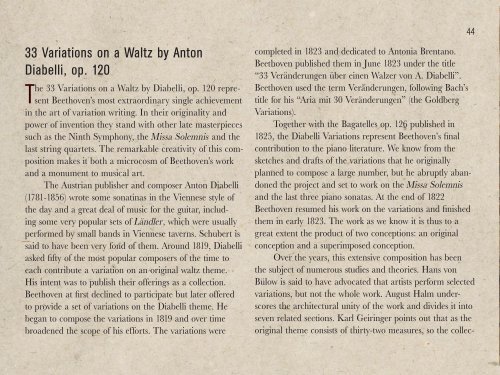LATE BEETHOVEN LATE BEETHOVEN - Luisa Guembes-Buchanan
LATE BEETHOVEN LATE BEETHOVEN - Luisa Guembes-Buchanan
LATE BEETHOVEN LATE BEETHOVEN - Luisa Guembes-Buchanan
Erfolgreiche ePaper selbst erstellen
Machen Sie aus Ihren PDF Publikationen ein blätterbares Flipbook mit unserer einzigartigen Google optimierten e-Paper Software.
33 Variations on a Waltz by Anton<br />
Diabelli, op. 120<br />
The 33 Variations on a Waltz by Diabelli, op. 120 represent<br />
Beethoven’s most extraordinary single achievement<br />
in the art of variation writing. In their originality and<br />
power of invention they stand with other late masterpieces<br />
such as the Ninth Symphony, the Missa Solemnis and the<br />
last string quartets. The remarkable creativity of this composition<br />
makes it both a microcosm of Beethoven’s work<br />
and a monument to musical art.<br />
The Austrian publisher and composer Anton Diabelli<br />
(1781-1856) wrote some sonatinas in the Viennese style of<br />
the day and a great deal of music for the guitar, including<br />
some very popular sets of Ländler, which were usually<br />
performed by small bands in Viennese taverns. Schubert is<br />
said to have been very fond of them. Around 1819, Diabelli<br />
asked fifty of the most popular composers of the time to<br />
each contribute a variation on an original waltz theme.<br />
His intent was to publish their offerings as a collection.<br />
Beethoven at first declined to participate but later offered<br />
to provide a set of variations on the Diabelli theme. He<br />
began to compose the variations in 1819 and over time<br />
broadened the scope of his efforts. The variations were<br />
44<br />
completed in 1823 and dedicated to Antonia Brentano.<br />
Beethoven published them in June 1823 under the title<br />
“33 Veränderungen über einen Walzer von A. Diabelli”.<br />
Beethoven used the term Veränderungen, following Bach’s<br />
title for his “Aria mit 30 Veränderungen” (the Goldberg<br />
Variations).<br />
Together with the Bagatelles op. 126 published in<br />
1825, the Diabelli Variations represent Beethoven’s final<br />
contribution to the piano literature. We know from the<br />
sketches and drafts of the variations that he originally<br />
planned to compose a large number, but he abruptly abandoned<br />
the project and set to work on the Missa Solemnis<br />
and the last three piano sonatas. At the end of 1822<br />
Beethoven resumed his work on the variations and finished<br />
them in early 1823. The work as we know it is thus to a<br />
great extent the product of two conceptions: an original<br />
conception and a superimposed conception.<br />
Over the years, this extensive composition has been<br />
the subject of numerous studies and theories. Hans von<br />
Bülow is said to have advocated that artists perform selected<br />
variations, but not the whole work. August Halm underscores<br />
the architectural unity of the work and divides it into<br />
seven related sections. Karl Geiringer points out that as the<br />
original theme consists of thirty-two measures, so the collec-


